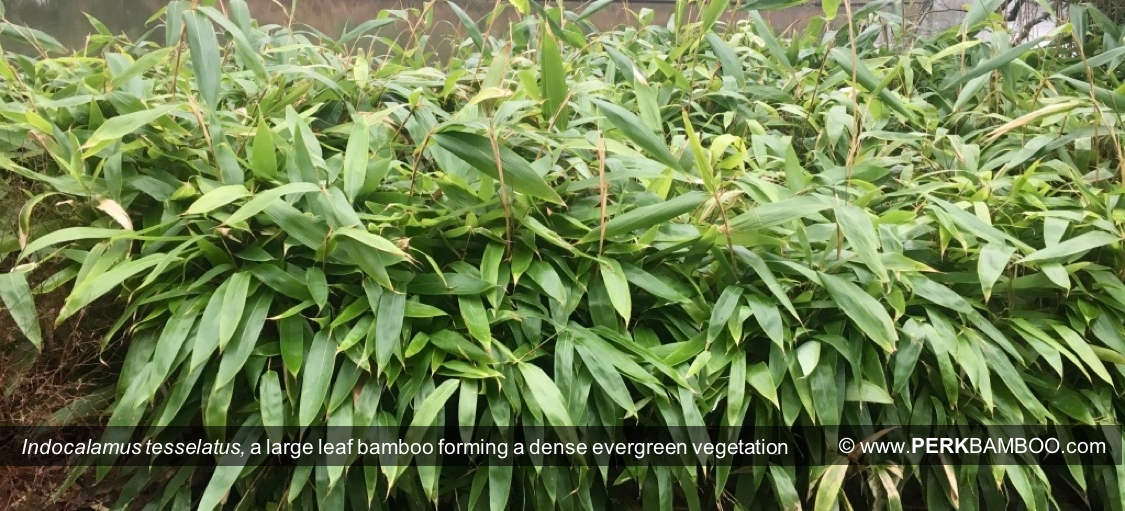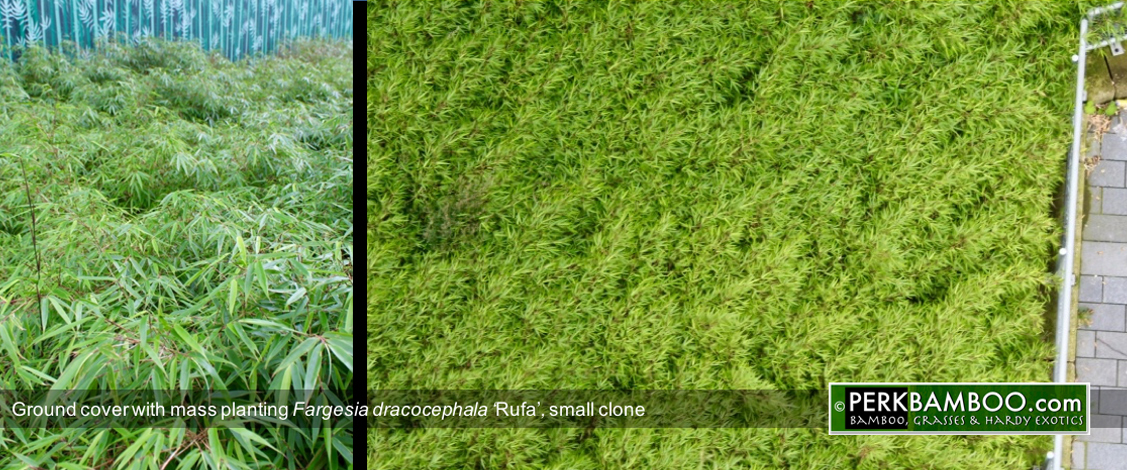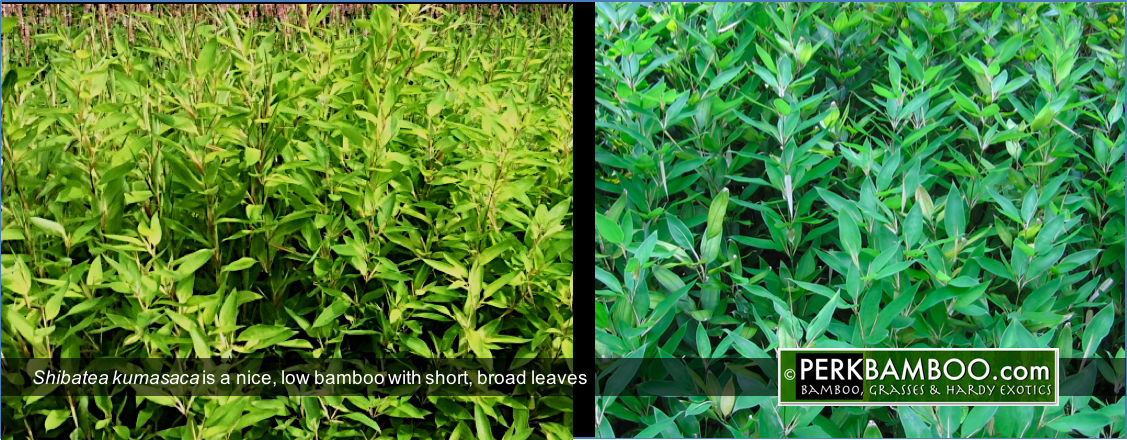BAMBOO - GROUNDCOVER
Several bamboos can be used as ideal evergreen, low-maintenance ground cover for planting areas in private gardens, parks and public space. Species that produce rhizomes are particularly suitable for covering a planting area quickly. After vegetation closure the maintenance is minimal. Further expansion can be controlled by using root barrier around the planting area (available at our nursery). In this way soil erosion is prevented on slopes, hills, road sides, dikes and along ditches. Maintenance is limited to some pruning or mowing of the old foliage. Species suitable for this application are described here:
INDOCALAMUS TESSELATUS
The bamboo with the largest leafs, up to 60 x 10 cm. The total plant height is 1-1,5 meter (in sheltered places higher). The large hanging leaves falling over each other like roof tiles, creating a closed canopy. Perfect to prevent weed growth because the dense canopy will not transmit light to the ground. The large leaves of this species are popular in Asian cuisine to wrap food. A very good plant to give a tropical touch to the garden. I also use this species as undergrowth in a bamboo grove.

PLEIOBLASTUS PYGMAEUS
One of the smallest rhizomatous species of bamboo with striking leaves (growth height 20-40 cm). This species can be used for bonsai cultivation, as ground cover and even as a bamboo lawn if mowed periodically. Nice as evergreen undergrowth for a high bamboo grove.

PLEIOBLASTUS FORTUNEI
A low, ground cover species (50-70 cm) with striking fan-shaped leaves arranged in a green-white variegation. The foliage freezes in severe winters but the plant is fully root hardy. After winter you can cut back the old leaves to allow it to regrow a dense math with fresh, white-green leaves. Low bamboos like these can significantly expand. Usage in combination with perennials is unwise because they compete out other plants eventually. In combination with shrubs or as understory for high bamboos, Pleioblastus bamboos are nice to use. Also ideal for filling pockets (with root barrier around the edges). Or in large plant containers.

PLEIOBLASTUS VIRIDI-STRIATUS ‘AURICOMA’
A beautiful bamboo because of its special leaf color. The new leaves have a fluorescent yellow green color which later turns into lime-green with fine green lines. Later in the season the leaves turn to mixed greens. ‘Auricoma’ is a relatively low ground cover (50-80 cm) for sun to (partial) shade (foliage color is best in partial shade). The leaves wither in the course of the winter. In spring ‘Auricoma’ needs to be cut back to ground level and will resprout vigourly from its rootsystem.

SASA KURILENSIS
Naturally the most up north growing bamboo (Russian Kurillen Islands northeast of Japan, 50gr NB). A very strong bamboo (100-150 cm) with strong expansion drive. An excellent ground cover with beautiful wavy leaves to cover larger areas quickly. Tolerates shade well and can also be applied in large planting containers. Fully hardy and evergreen. The rootsystem needs to be controlled by bamboo barrier

SASA VEITCHII
A particularly valuable bamboo in places where the winter image of a garden is decisive. In the autumn, discoloration of the leaf margins takes place from green to paper white (it's actually a drying process in preparation for the winter), creating a variegated effect. The leaf is quite large (25 x 5 cm), but the plant remains low (80-150 cm). Regular pruning of the whole plant promotes fresh regrowth and creates a more compact plant. Although difficult to propagate there are usually plants available at the nursery. It is an excellent plant for the Japanese garden.

SASAELLA MASAMUENA 'ALBOSTRIATA'
One of the strongest, low bamboos. Even after a severe winter still pretty green. Also a low-ground cover with a height of 50-100 cm. The main decorative value is in the leaf color variation: in spring butter yellow leaves, variegated leaves (with dark green, light green and yellow-white) and largely dark green leaves with a single yellow line appear. In autumn the leaves largely turn into greens. On heavier (clay)soil types low rhizome production. Cut back the plant every few years to promote compact, dense growth with lots of fresh shoots.

SASA PALMATA 'NEBULOSA'
The natural habitat of this species is found in the mountainous areas of Japan where Sasa palmata (spotted palm bamboo) covers large areas. In our garden it must be controlled with root barrier. This is the way to grow a beautiful, compact plant. This species is 150-250 cm tall. Special ornamental value of this plant are the big leaves arranged in a (palm) fan on black spotted culms. Even in mid-winter with fog and cold, it is still a beautiful plant that draws attention. Especially with some frost on the leaf margins. This species is at its best in more open areas in large gardens and parks.

SHIBATAEA KUMASASA
This is one of the finest small garden bamboos with a height of 40-60cm. The evergreen, almost teardrop-shaped leaves are arranged in a zig-zag pattern along each stem. It is a compact grower and a very slow spreader, not becoming rampant in the garden. Shibataea kumasasa maintains its best color in part to full shade, providing an interesting texture to a shady landscape.



